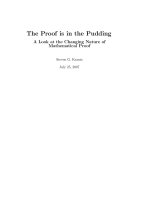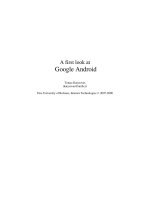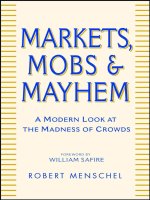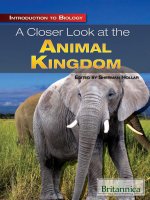Lesson Unit 1: A first look at the UK and the U.S.
Bạn đang xem bản rút gọn của tài liệu. Xem và tải ngay bản đầy đủ của tài liệu tại đây (5.25 MB, 72 trang )
Unit 1: A first look at the UK and
the U.S.
Lecturer: Vũ Thị Luyên
Contents
A first look at the United Kingdom
A first look at the United States
A first look at the United
Kingdom
A. Map of the United Kingdom
B. Understanding Names
C. History and meaning of the Union
Jack
D. Things British
A. Map of the United
Kingdom
Great
Britain
The United
Kingdom
England
B. Understanding names
1.
Great Britain
2.
United Kingdom
3.
The British Isles
4.
The British Commonwealth of Nations
Great Britain
• the official name given to the two kingdoms
of England and Scotland, and the principality
of Wales.
• also includes the small islands except the
Channel Islands and the Isle of Man.
• sometimes people use the shorten name
“Britain”.
• the term “England” should NEVER be used
to describe Britain.
United Kingdom
•
Together
with
the
province
of
Northern Ireland, Great Britain is part of
the United Kingdom (UK).
• Official name is the “United Kingdom
of Great Britain and Northern Ireland”.
• The UK is the member of the
European Union (EU).
The British Isles
• The British Isles* consists of: Great Britain
(England, Scotland, and Wales); the whole of
Ireland, the Orkney and Shetland Islands, the Isle of
Man, the Inner and Outer Herbrides, and the Isle of
Wight, Scilly Islands, Lundy Island, the Channel
Islands and many other offshore islands.
• Great Britain is the largest island in the British
Isles.
*
Isle: an Island
The British Commonwealth of
Nations
• the former name of the Commonwealth of
Nations: an association of nations consisting of
the United Kingdom + its dependencies + many
former British colonies (now sovereign states but
owe allegiance to the British Crown).
• Today there are 54 Commonwealth nations.
• The British Monarch is considered the head of
state in only 16 commonwealth countries.
C. History and meaning of
the Union Jack
• Names: Royal Banner, Union Jack, Union
Flag
• Actually three flags in one: the England flag,
the Scotland flag, and the patron saint of
Ireland’s flag.
• The emblems appearing on the Union Jack
are the crosses of three patron saints.
C. History and meaning
of the Union Jack
• England is represented by the flag of St. George
• In 1194 A.D, Richard I introduced the Cross of St.
George – a red cross on a white ground as a
national flag of England
England’s flag
C. History and meaning
of the Union Jack
• Scotland is represented by the flag of
St. Andrew – a diagonal white cross on
a blue background.
Scotland’s flag
C. History and meaning
of the Union Jack
• When King James VI of Scotland became King
James I of England, the two union of the two realms
under ONE King was represented symbolically by a
new flag.
• On 12th April 1606, the first flag of the union was
created.
• The red cross of the England was superimposed on
the white cross of Scotland on the blue background
of the Scotland flag.
C. History and meaning
of the Union Jack
• Ireland is represented by the flag of St. Patrick – a
diagonal red cross on a white background.
• In 1801, King George III added the cross of St.
Patrick to the Union Flag, to make the Union Jack
we have today.
Ireland’s flag
C. History and meaning
of the Union Jack
• The designers made the background of the
white Scottish cross broader on one side of
the Irish red than on the other.
All the separate crosses could be seen and the
Irish Cross has it original background
C. History and meaning of
the Union Jack
• The Welsh dragon does not appear on the
flag because when the 1st Union Jack was
created in 1606, Wales was already united with
England.
Wales’s flag
C. History and meaning of
the Union Jack
• Both the name and the design of the British flag
emphasize the United Kingdom of Great Britain and
Northern Ireland as a union of nations.
• The countries comprising the UK are not isolated
states, together they constitute a powerful union.
• Symbolizes the respect for individuality within a
closely knit community.
D. Things British
1.
British National Anthem
2.
The British Monarch
3.
The Royal Coat of Arms and the Shield
4.
Britannia
5.
John Bull
6.
The Bulldog
7.
The Robin
8.
The Bowler Hat
9.
Football
10.
Tea
1. British National
Anthem
• “God save the Queen” (traditional music of
unknown author), first performed in 1740s,
became known as the British national anthem
from the beginning of the 19th century.
• When the British monarch is male “God save
the Queen” becomes “God save the King”.
• Represents the whole of the UK.
1. British National
Anthem
• However, when an anthem is needed for one of the
component countries of the UK, an alternate song is used.
Wales – Hen Wlad Fy Nhadau (Land Of My Fathers) by Evan
and James James.
Scotland – Flower of Scotland by Roy Williamson
Ireland – Ambran na bbFiann (The Soldier’s Song) by
Peadar Kearney and Patrick Heaney.
England’s most patriotic song – Jerusalem by William
Blake
2. The British Monarch
• is the head of state of the United Kingdom and its
oversea territories.
• plays an important ceremonial role but has almost
no real power in politics.
• The current monarch is Queen Elizabeth II (since
February 6th, 1952).
• The primary role of Elizabeth has been as a symbol
of unity and continuity within the Commonwealth of
Nations.
2. The British Monarch
• The current heir is Charles, Prince of Wales (son
of the Queen).
• Buckingham Palace is the official town residence
of the British monarch since 1837, located near
Saint James’s Park, London.
2. The British Monarch
• It has about 600 rooms and 20 hectares of
gardens.
2. The British Monarchy
Prince Philip – Duke of
Edinburgh
Prince of Wales Charles
Princess of
Wales - Diana
Queen Elizabeth II
Duke of Cambridge- Prince Harry of
William
Wales









